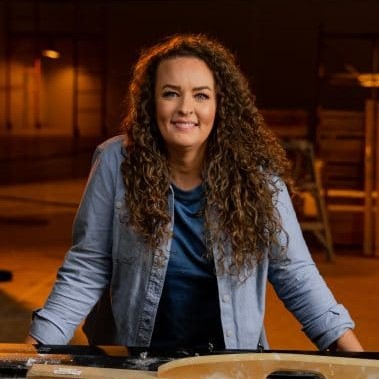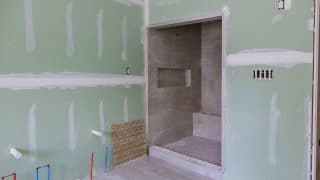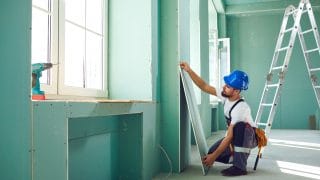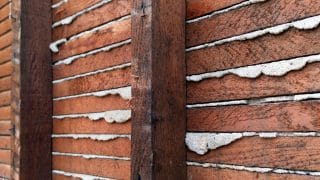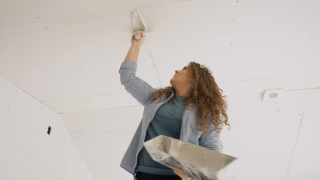
Drywall is an excellent building product—the sheets are relatively easy to hang (compared to old-school plaster and lathe), and most folks can learn to mud and tape a drywall joint fairly quickly. One aspect to mudding and taping (the process of making all the sheets look like one plane) is learning how to patch screw or nail holes in drywall.
Nail and screw holes occur for a few different reasons. For one, hanging a piece of drywall involves driving a nail or screw through the front of the sheet and into the wall stud behind, leaving roughly 30 holes in a sheet. Secondly, hanging a picture or a shelf from a wall requires creating a hole in the drywall. Of course, holes can just happen in drywalls as well (maybe your kid accidentally butted her hockey stick through the wall). Regardless of the reason for the hole in your wall, this guide will cover how to patch screw or nail holes in drywall.
Equipment needed to patch screw or nail holes in the wall
- Hammer
- Screw gun
- Utility knife
- Putty knife
- Joint compound or spackle
- Powdered joint compound or Plaster of Paris (both optional)
- Paddle mixer
- Compound or tray
- Drywall tape (depending on the size of the hole)
- Sanding block or sponge
How to patch screw or nail holes in drywall
Patching holes in your drywall is a fairly simple task that you can probably do yourself without calling a repair person.
1. Assess and prepare the hole
There are some slight differences in technique when patching different holes, though the process remains mostly the same. You’ll need to determine whether the hole is from nails or screws driven during installation, an anchor used to hold up a heavy object, or simply a small hole from hanging a picture.
- For installation nails and screw holes in drywall, be sure that the fastener’s head is below the drywall surface. Use a hammer to drive the nail deeper or a screw gun to tighten the drywall screw. Don’t overdrive the fastener—just below the surface is ideal.
- For anchors, remove the anchor from the wall and tap the hole with a hammer so it’s slightly below the wall surface. For large holes (½-inch or so), roll up drywall tape and fill the hole snuggly. If the anchor doesn’t come out, simply tap it below the drywall surface.
- For small holes, just tap the nail hole with a hammer to drive it below the drywall surface and create a small indentation.
You can scrape the blade of the putty knife over the screw hole to ensure it’s smooth and remove any flaked paint. Also, remove any loose drywall paper with the utility knife.
2. Prepare the compound
Fresh buckets of drywall compound often need a good mixing before they’re ready for use. If you have a paddle mixer, tighten it in your drill and mix the compound, being careful not to lift the spinning paddle above the bucket. If you don’t have a paddle, you can mix it with a putty knife. Just be sure to mix until any separated water incorporates with the mix.
Once mixed, scoop a bit of compound out onto the hawk or into the tray and clean off the putty knife.
Drywall is an excellent building product—the sheets are relatively easy to hang (compared to old-school plaster and lathe), and most folks can learn to mud and tape a drywall joint fairly quickly. One aspect to mudding and taping (the process of making all the sheets look like one plane) is learning how to patch screw or nail holes in drywall.
Nail and screw holes occur for a few different reasons. For one, hanging a piece of drywall involves driving a nail or screw through the front of the sheet and into the wall stud behind, leaving roughly 30 holes in a sheet. Secondly, hanging a picture or a shelf from a wall requires creating a hole in the drywall. Of course, holes can just happen in drywalls as well (maybe your kid accidentally butted her hockey stick through the wall). Regardless of the reason for the hole in your wall, this guide will cover how to patch screw or nail holes in drywall.
Equipment needed to patch screw or nail holes in the wall
- Hammer
- Screw gun
- Utility knife
- Putty knife
- Joint compound or spackle
- Powdered joint compound or Plaster of Paris (both optional)
- Paddle mixer
- Compound or tray
- Drywall tape (depending on the size of the hole)
- Sanding block or sponge
How to patch screw or nail holes in drywall
Patching holes in your drywall is a fairly simple task that you can probably do yourself without calling a repair person.
1. Assess and prepare the hole
There are some slight differences in technique when patching different holes, though the process remains mostly the same. You’ll need to determine whether the hole is from nails or screws driven during installation, an anchor used to hold up a heavy object, or simply a small hole from hanging a picture.
- For installation nails and screw holes in drywall, be sure that the fastener’s head is below the drywall surface. Use a hammer to drive the nail deeper or a screw gun to tighten the drywall screw. Don’t overdrive the fastener—just below the surface is ideal.
- For anchors, remove the anchor from the wall and tap the hole with a hammer so it’s slightly below the wall surface. For large holes (½-inch or so), roll up drywall tape and fill the hole snuggly. If the anchor doesn’t come out, simply tap it below the drywall surface.
- For small holes, just tap the nail hole with a hammer to drive it below the drywall surface and create a small indentation.
You can scrape the blade of the putty knife over the screw hole to ensure it’s smooth and remove any flaked paint. Also, remove any loose drywall paper with the utility knife.
2. Prepare the compound
Fresh buckets of drywall compound often need a good mixing before they’re ready for use. If you have a paddle mixer, tighten it in your drill and mix the compound, being careful not to lift the spinning paddle above the bucket. If you don’t have a paddle, you can mix it with a putty knife. Just be sure to mix until any separated water incorporates with the mix.
Once mixed, scoop a bit of compound out onto the hawk or into the tray and clean off the putty knife.
Tip: If you’d like a faster-drying patching compound, you can mix additional powdered joint compound (also known as hot mud) or Plaster of Paris into the mix. A little goes a long way, so add it sparingly.
3. Apply the first coat
Grab a bit of joint compound with the end of a clean putty knife and scrape away the excess mud on the back of the knife. Holding the knife at a shallow angle above the hole, drag the knife down over the hole while pushing mud into the hole and indentation. After cleaning the blade, hold the knife at a sharper angle (around 45 degrees) and drag it across the hole (left to right or right to left) to remove the excess compound.
If the compound appears to bubble or pool a bit in the hole, poke it with the point of the putty knife to release the trapped air.
4. Sand the area
After allowing the compound to dry completely (at least an hour, depending on hole size and humidity), use the sanding block to remove the excess dried compound and smooth the surface. This sanding is not a finish coat, so it does not need to be perfect. Simply remove the high spots so the next coat can go on smoothly and uniformly.
5. Apply the second coat
Apply the second coat in the same manner as the first. Use a clean putty knife to grab some joint compound, drag the mud over the hole with the knife at a shallow angle, and remove the excess mud by dragging the knife perpendicular to the first pass. There shouldn’t be any bubbling or pooling at this step, as long as the previous coat dried sufficiently.
6. Sand the patched area
The second coat will take less time to dry, but you should still wait at least an hour before sanding. Once dry, use the sanding block to sand the compound to a smooth finish. In some cases, this will be the final sanding, so take care to sand so there aren’t any ridges or high spots. If the hole is still apparent, apply a third coat.
MT Copeland offers video-based online classes that give you a foundation in construction fundamentals with real-world applications, like installing drywall. Classes include professionally produced videos taught by practicing craftspeople, and supplementary downloads like quizzes, blueprints, and other materials to help you master the skills.

